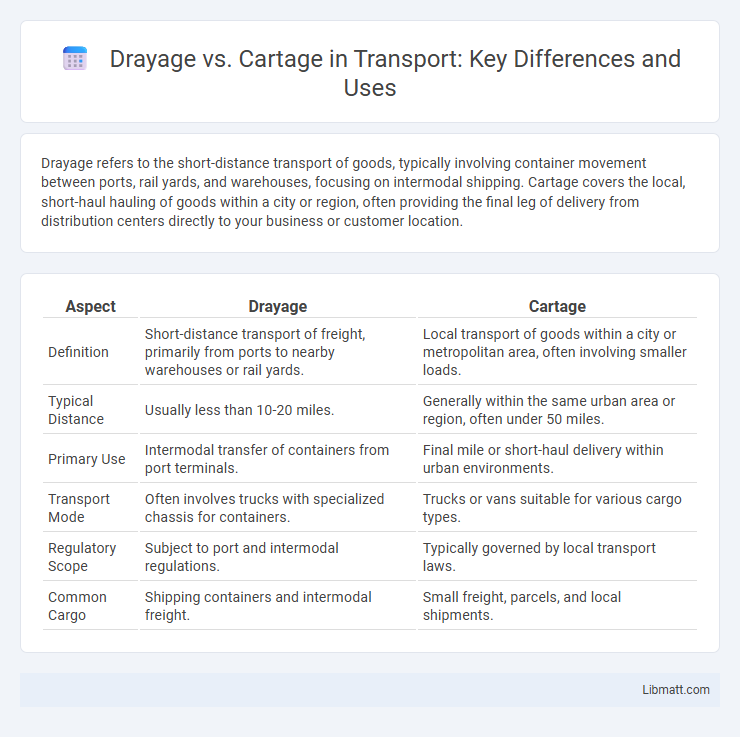Drayage refers to the short-distance transport of goods, typically involving container movement between ports, rail yards, and warehouses, focusing on intermodal shipping. Cartage covers the local, short-haul hauling of goods within a city or region, often providing the final leg of delivery from distribution centers directly to your business or customer location.
Table of Comparison
| Aspect | Drayage | Cartage |
|---|---|---|
| Definition | Short-distance transport of freight, primarily from ports to nearby warehouses or rail yards. | Local transport of goods within a city or metropolitan area, often involving smaller loads. |
| Typical Distance | Usually less than 10-20 miles. | Generally within the same urban area or region, often under 50 miles. |
| Primary Use | Intermodal transfer of containers from port terminals. | Final mile or short-haul delivery within urban environments. |
| Transport Mode | Often involves trucks with specialized chassis for containers. | Trucks or vans suitable for various cargo types. |
| Regulatory Scope | Subject to port and intermodal regulations. | Typically governed by local transport laws. |
| Common Cargo | Shipping containers and intermodal freight. | Small freight, parcels, and local shipments. |
Introduction to Drayage and Cartage
Drayage refers to the short-distance transportation of freight, typically involving the movement of containers between ports, rail yards, and warehouses, playing a crucial role in supply chain efficiency. Cartage covers local delivery and pick-up services, often within urban areas, facilitating last-mile distribution and short haul transport. You can optimize logistics by understanding how drayage handles port-related transit while cartage focuses on local freight movements.
Definition of Drayage
Drayage refers to the transport of goods over a short distance, typically involving the movement of containers or cargo between a port, rail terminal, or warehouse within the same urban area. This specialized service plays a crucial role in the logistics and supply chain industry by facilitating the seamless transfer of freight between large-scale transportation modes. Key components of drayage include container hauling, port pick-up, and delivery to distribution centers or intermodal yards.
Definition of Cartage
Cartage refers to the local transportation of goods over short distances, typically within the same metropolitan area or city, often involving deliveries from warehouses to retail locations. Unlike drayage, which specifically involves moving containers between ports and nearby facilities, cartage encompasses general freight movement without containerization constraints. This service is crucial for last-mile delivery, ensuring efficient distribution in urban logistics networks.
Historical Background of Drayage and Cartage
Drayage originated in the 18th century as horse-drawn carts transported goods short distances between docks and warehouses, forming a critical link in maritime trade logistics. Cartage developed alongside urban expansion, referring to local delivery services using wagons or trucks to move goods within city limits. Understanding the historical roots of drayage and cartage can help you appreciate their evolving roles in modern supply chain management.
Key Differences Between Drayage and Cartage
Drayage primarily involves the short-distance transport of containers and goods within port terminals or between ports and rail yards, emphasizing container handling logistics. Cartage refers to the local transportation of smaller freight shipments, often over short distances within urban or metropolitan areas, focusing on flexibility and last-mile delivery. Understanding these key differences helps you choose the right service for efficient supply chain management and cost optimization.
Common Use Cases for Drayage
Drayage primarily involves the short-distance transport of freight containers between ports, rail terminals, and warehouses, typically spanning a few miles. Common use cases include moving imported shipping containers from a port terminal to a nearby distribution center or transferring cargo between different modes of transportation in intermodal shipping. This service is vital in supply chain logistics, facilitating efficient last-mile delivery and minimizing delays in freight handling.
Typical Applications of Cartage
Cartage typically involves short-distance transportation of goods within urban or metropolitan areas, often connecting warehouses, distribution centers, and retail outlets. It is commonly used for last-mile delivery, local freight movement, and transporting goods that are too bulky or heavy for standard parcel services. Industries such as retail, manufacturing, and construction frequently rely on cartage for efficient intracity logistics and timely material handling.
Cost Comparison: Drayage vs Cartage
Drayage typically involves shorter distances within port or rail terminals and incurs higher fees due to container handling and terminal charges, making it more expensive per mile compared to cartage. Cartage covers local freight transport over short distances, often within a metropolitan area, with lower overall costs since it excludes port-related fees. Your choice between drayage and cartage directly impacts logistics expenses based on distance, container handling, and regional transport conditions.
Choosing the Right Service for Your Supply Chain
Drayage involves short-distance hauling of containers between ports, rail yards, and warehouses, optimizing international import and export logistics. Cartage covers local freight transport within urban areas, facilitating efficient last-mile deliveries and regional distribution. Selecting the right service depends on your supply chain's geographic scope, delivery timelines, and cargo type to ensure cost-effective and timely transportation.
Future Trends in Drayage and Cartage
The future trends in drayage and cartage emphasize increasing adoption of electric and autonomous vehicles to reduce carbon emissions and improve efficiency in short-haul trucking. Integration of real-time tracking technology and advanced logistics software enhances supply chain visibility and optimizes route planning for both drayage and cartage operations. Growing regulatory pressures and sustainability goals drive investment in greener infrastructure and multimodal transport solutions that blend drayage and cartage services.
drayage vs cartage Infographic

 libmatt.com
libmatt.com